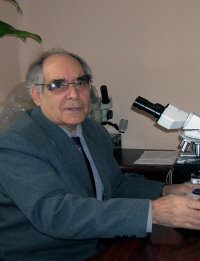Interview with Inventor
Interview with Prof. David Teply Concerning Means to Model Chronic Fatigue Experimentally
 – Please tell us about the reasons why you initiated your research.
– Please tell us about the reasons why you initiated your research.
– The last millennium is a period full of powerful psychic, emotional, physical, and social loads, which are due to informatization and urbanization processes. Social changes caused a special form of pathology, from which a lot of people suffer. The name of that pathology is the chronic fatigue syndrome. This name was attributed to it in 1994; yet, this pathology hasn’t still been researched profoundly enough – especially its development mechanisms. Actually, that’s a chronic stress caused by such factors as the sped-up life rhythm, more and more problems to face, continuous anxieties, large information flows, and so on.
The unity of the most crucial systems (the nervous one, the immune one, and the endocrine one), which regulate functions in a living organism, is involved in the development of stress. Many scientists research development mechanisms of the chronic fatigue syndrome, as well as possible ways to prevent and treat it. We got interested in that, too.
– How did you carry out your research?
– As disorder of function regulatory systems is of complex character in case of the chronic fatigue syndrome, we set ourselves the primary goal to create an experimental model of this form of pathology by using purebred laboratory rats as research objects. A specific feature of our model was to create a complex of exhausting impacts upon the animals’ psychic, emotional, and physical state, as well as upon their cognitive functions. It was of real value to determine efficiency of these or those medicines to prevent and possibly to correct disorders caused by the chronic fatigue syndrome.
We took three essential factors into account. First, the information impact. It was based on formation of rats’ food-searching behavior by placing them into a complicated labyrinth and changing the structure of that labyrinth once in two days, which was quite a difficult task for their brains to tackle. Second, the physical impact – swimming with a load. Third, the social factor: it was formed by making male rats experience their victories and defeats repeatedly; a regular confrontation made them feel depressed. As for agents for pharmacological correction of the chronic fatigue development, stuff of the so-called GABA system was efficient enough. This system was acknowledged as the main stress-limiting system to form an organism’s reaction to stress long ago. We decided that some derivatives of the GABA system (phenybut, phenotropil, etc.) are able to reduce the chronic fatigue syndrome. After we applied that stuff, the level of so-called free radicals (which are toxic for an organism) decreased; the immunity level (which had gone down during our experiment) went up. Therefore, we made the conclusion that those agents may be applied to treat chronic fatigue not only as an experiment. Once we undertake further research, it can be extrapolated to humans.
– Who took part in this research?
– Besides me, our research team includes Professor Marina Samotrueva, Doctor of Medicine, Head of the Chair of Pharmacognosy, Pharmaceutical Technologies, and Biotechnology of Astrakhan State Medical University, as well as two postgraduates of the same Chair – Tatyana Serezhnikova and Nadiya Kuleshevskaya.
– What are the prospects of your project?
– Our research relates to experimental medicine, and it’s going on. We have many aspects for further studies. New results may be used to research therapeutic effect of structural derivatives of the GABA system and (maybe) other agents to treat chronic fatigue.
Interviewed by T.Yu. Gavrilkina (the Web Resources Information Support Directorate of ASU)
July 05, 2016
Translated by E.I. Glinchevskiy (the Center of Translation Studies & Conference Interpreting “ASTLINK” of ASU)




